Scottish Premiership Football has just kicked off for another season.
Eyes from across the world will be firmly locked on the two giant Glaswegian clubs, Celtic and Rangers.
However, many people are quick to judge the level of talent in Scotland, with there being a multitude of talent across the top divisions.
Last season, the Scottish Championship saw some significant big names competing in the second tier.
Big clubs such as Dundee United and Partick Thistle fought for promotion, while former internationals Aiden McGeady and Tony Watt plied their trade in the division, too.
Some of Scotland’s biggest clubs have recognised this level of quality, loaning out some of their prized prospects last season to the Scottish Championship.
In this tactical analysis and Scottish Premiership scout report, we will provide an in-depth analysis of three players who spent time on loan in the Scottish Championship last season.
This analysis will highlight where the players excelled while on loan within their loan side’s tactics and what they must improve if they wish to claim a starting spot at their parent club.
Kanayo Megwa (Airdrieonians: On Loan From Hibernian)
Kanayo Megwa, born and raised in London, signed for Hibernian in 2021.
The 20-year-old had spent time at EFL Championship clubs such as Watford and West Brom before making the move north of the border.
After a successful loan spell in Scottish League 1 with Kelty Hearts, Megwa was loaned out to Airdrieonians for the 2023/24 season.
His performances for the North Lanarkshire club have certainly caught many people’s attention.
Megwa can be utilised in several positions.
Depending on Airdrieonians’ formation, Megwa played as either a right-back or a right wing-back.
He also proved his versatility by filling in as a right centre-back in a back three and left-back on several occasions.

As seen by Megwa’s heatmap, he didn’t need an invitation to get forward.
Megwa was constantly bombing forward with and without the ball.
Often, he could be found making advancing runs for players to pick him out with long passes.
When in possession, he could be found driving past opponents with the ball.
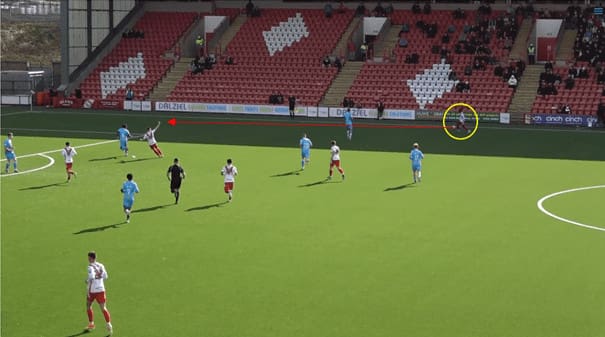
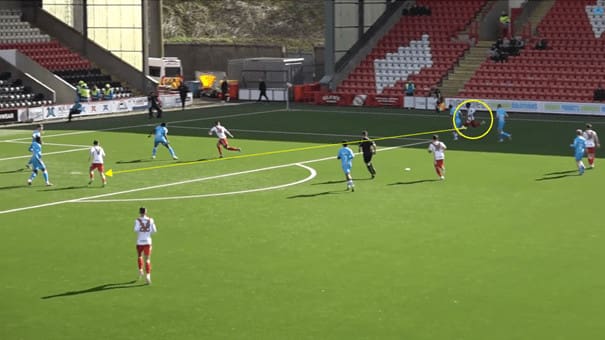
In this example, Megwa picks up the ball after making a run forward.
He quickly drives at the opposition’s full-back, using his pace to beat his opponent.
After creating a yard of space, he delivers an excellent ball into the box for his teammates to attack.
Megwa was evidently one of the standout performers when it came to beating players in the Scottish Championship last season.
He averaged 3.23 dribbles per 90 seconds with a success rate of 63.7%, the fourth highest in the division.
When compared with right-backs in the Scottish Championship, he had a percentile rank of 84.9 for dribbles per 90 seconds.
Once Megwa got into these advanced positions, his crossing was of a decent standard.
Statistically, he averaged 2.7 crosses per 90 with a 40% accuracy, the 11th highest in the league.
However, Megwa’s productivity from crosses was low.
He finished the season with only one assist and had an expected assists tally of 3.06.
He had a percentile rank of only 46.53 for dangerous passes per 90 when compared with other right-backs in the Scottish Championship last season.
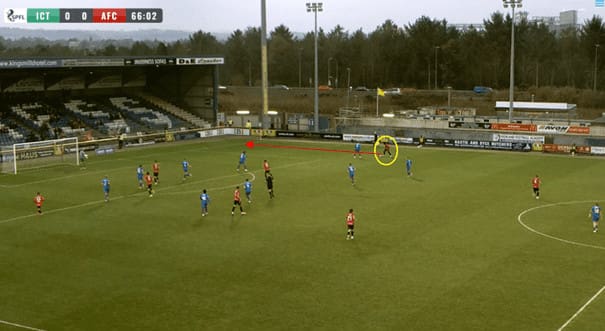
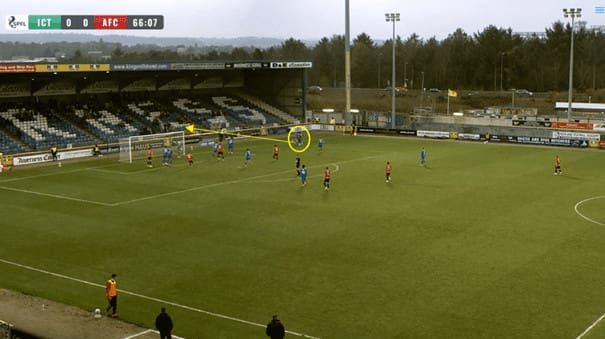
In this situation, we see Megwa using his speed and 1v1 attacking ability to great effect.
He bursts past the opposition’s full-back with great ease, allowing him to get to the byline and deliver a cross.
However, he misses the ball, slicing the cross, leading to the ball going out for a goal kick.
Megwa has proven that not only does he possess quality in possession, but he also has many qualities when defending.
He uses his blistering pace and exceptional agility when pressing to help him win the ball back from his opponents.
Megwa demonstrated this most successfully during the defensive transition.
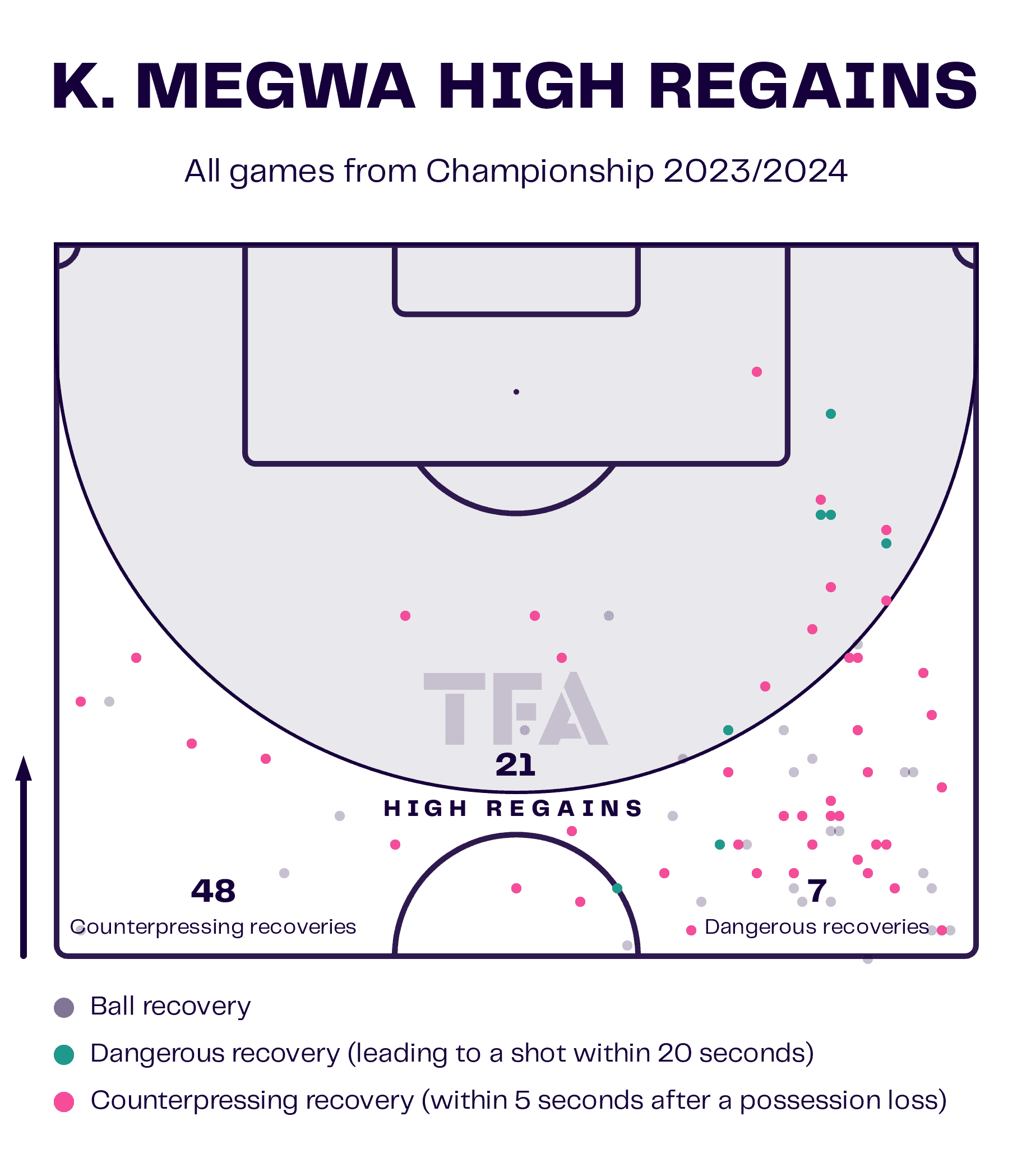
This graphic demonstrates the significant number of counter-pressing recoveries Megwa made in the opponent’s half.
This becomes even more impressive when you consider Megwa made only 27.1% of his recoveries in the opposition’s half.
Megwa’s ability when pressing and defending 1v1 can also be seen in the fact he won 60.9% of defensive duels.
Yet this isn’t his only strength when defending.
Megwa has shown through using both his athleticism and intelligence to be highly effective at making interceptions.
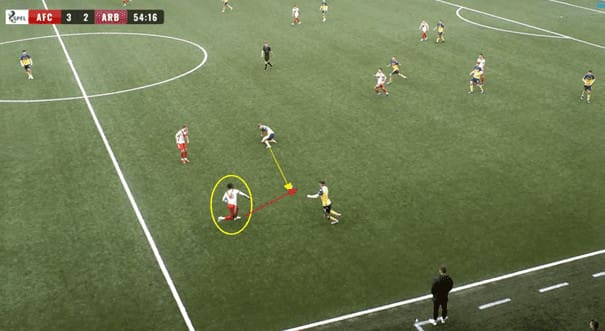
Here, Megwa sees an opportunity to win the ball.
He reads the opposition’s midfielder’s first-time pass to the left-winger.
Megwa uses his athleticism to step in and win the ball.
He is then quick to drive forward and start a dangerous counterattack.
Breaking into one of Scotland’s most established clubs will be a tall order for Megwa.
Internationals Chris Caden and Lewis Miller are Hibs’ current options for right-back.
Megwa may need to secure a loan move to a club in the Scottish Premiership or EFL League 2 to provide an opportunity for him to develop his ability to play for the Edinburgh club.
He has, however, put in performances that will attract many clubs, whether that is for a loan move or a permanent departure from Easter Road.
Lewis Neilson (Partick Thistle: On Loan From Heart Of Midlothian)
Heart of Midlothian FC have also seen value in using the Scottish Championship to provide a platform for their young talent to develop.
Lewis Neilson, 21, was loaned to Partick Thistle last season and played a vital role in the Glasgow club’s securing a spot in the playoffs.
A product of the Dundee United youth academy, the Scotland u21 international moved to Hearts in 2022.
After making 10 first-team appearances for the Jambons, he was loaned out to Partick Thistle to get much-needed consistent first-team football to allow him to progress.
Neilson played in two positions throughout the season.
He began the season playing in his natural position of centre-back.
However, injuries resulted in a change of personnel, and Neilson was used as a number 6.
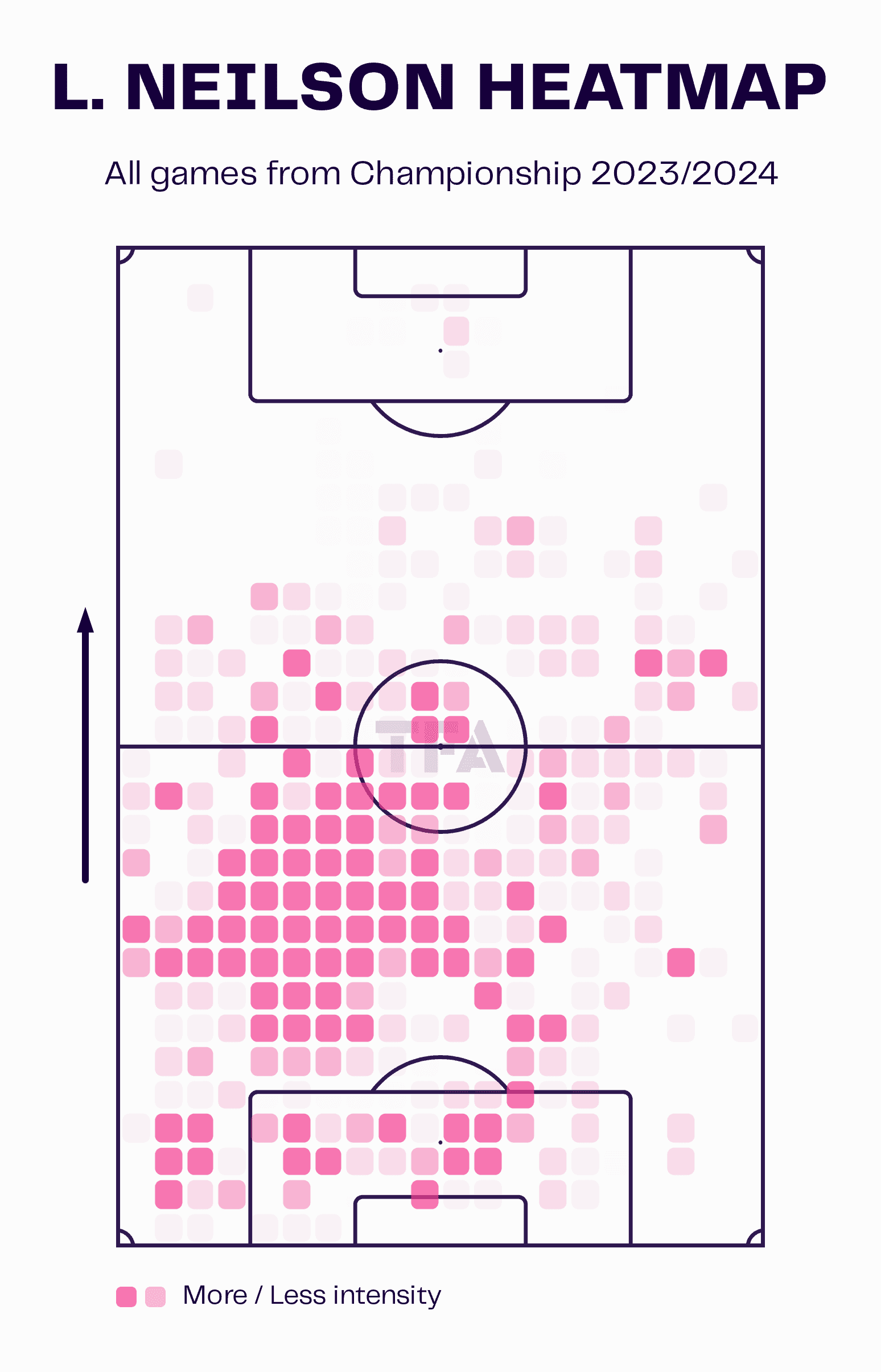
As seen from Neilson’s heat map, he played the majority of his minutes at centre-back on the left-hand side of the pitch.
It’s also clear that he spent a significant amount of time positioning himself in front of the defence, fulfilling his role as a number 6.
In possession, Neilson undoubtedly has the ability to progress play.
He averaged 15.05 forward passes per 90 with an accuracy rate of 71.1%.
He was able to play many passes into the feet of his midfielders, yet he often elected to play long diagonal passes to his teammates.
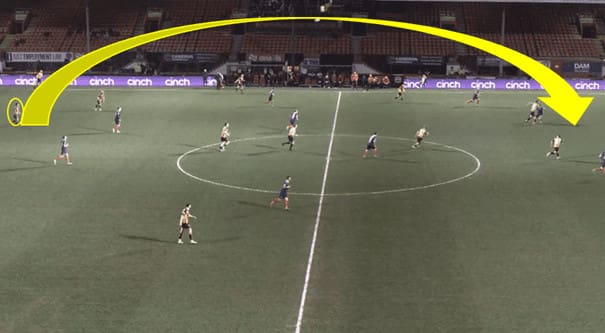
As seen here, Neilson has the ball deep in his own half.
None of the opposition’s forwards choose to aggressively press the centre-back.
Neilson takes advantage of this and plays an outstanding long ball over the top of the opposition’s defence for the run of his centre-forward.
Neilson averaged 6.3 long passes per 90.
He had an accuracy of 52.8%, highlighting the fact that despite his quality when playing long balls, many were intercepted.
He had a percentile rank of only 33 for accurate passes when compared to other centre-backs in the Scottish Championship.

Here, playing as the deepest midfielder, Neilson seeks to find the left-winger.
He plays a long diagonal ball, hoping to find the feet of his teammate.
However, the opposition’s right-back has a great starting position, allowing him to intercept Neilson’s attempt at playing forward.
Where Neilson really stands out is his ability to defend.
Last season, Neilson had the fourth-most defensive duels in the Scottish Championship, with an impressive success rate of 73.9%.
Neilson thrived in a variety of 1v1s.
He excelled when he was dragged out wide and often dominated centre-forwards when they had their backs to him.

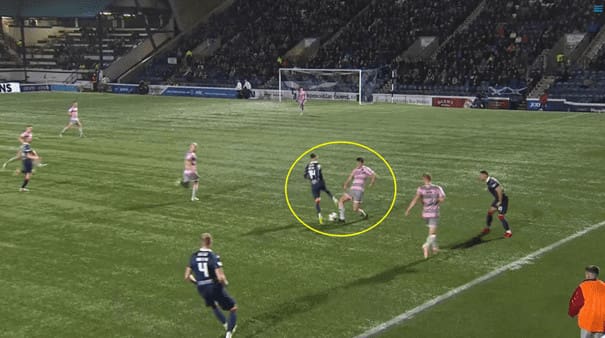
In this situation, Neilson remains tight to his direct opponent.
His aggressive nature and physicality led to his opponent losing control of the ball.
He then quickly steps in front of the forward and aggressively wins a 50/50 tackle against a challenging opponent.
Neilson had a percentile rank of 82.6 for percentage of defensive duels won per 90 when compared with other centre-backs.
Neilson caught the attention of many for his performances while on loan at Partick Thistle.
Hearts have recognised this and shown how much they value him by rewarding him with a new contract, extending his deal until June 2026.
Hearts have sent Neilson out on loan to Scottish Premiership club St. Johnstone who will allow Neilson to prove his worth in Scotland’s top flight.
Another successful year on loan could see Neilson state a claim for becoming a valued member of the Hearts squad.
Sam McClelland (Dundee United: On Loan From St. Johnstone)
Sam McClelland had a mixed year in his first season playing in Scotland.
McClelland came through Coleraine’s youth academy before making the move to Chelsea, where he continued his development.
After a loan period at EFL League 2 side Barrow, McClelland was released by Chelsea and snapped up by St. Johnstone in August 2023.
The Northern Ireland u21 International only managed to make seven first-team appearances for St. Johnston in the first half of the season.
McClelland was made available for loan to help him get more first-team minutes under his belt.
In February, he moved to Dundee United, where he played a crucial role in helping the Tangerines secure the Championship title and promotion back to Scotland’s top flight.
Despite only playing a handful of games, McClelland’s quality was clear for everyone to see upon his arrival at Dundee.
McClelland operated as a right centre-back in Dundee’s 4-2-3-1 formation.
In possession, McClelland was never afraid to ask for the ball.
He would constantly move and offer excellent supporting angles from under the ball.
This helped provide his teammates with an option under pressure, allowing possession to be recycled.

Here, Dundee United look to play the ball out from the back.
The opposition have pressed aggressively hoping to win the ball back in a dangerous area of the pitch.
Here, McClelland sees that his team is under pressure and offers a great supporting angle for his teammates, allowing pressure to be relieved.
Playing in a team that dominated the ball allowed McClelland to show his quality in possession.
The numbers clearly show this.
McClelland averaged 17.11 forward passes per 90 and 6.25 passes per 90 into the opposition’s final third with an accuracy of 71.1%.
Where McClelland shone was his ability to play long balls forward.
He averages 8.72 long balls per 90 with an accuracy of 62.3 %, the third highest in the league by an outfield player.


In this situation, McClelland has the ball in his own half.
Under pressure, he looks forward to finding a teammate.
He plays an excellent long pass into the feet of his centre-forward, allowing his team to progress up the pitch.
Defensively, McClelland showed a lot of quality.
He displayed a really aggressive nature when battling against the opposition’s centre-forwards.
Often, he would step in front of strikers, using his strength to physically outmuscle his opponents to win the ball.
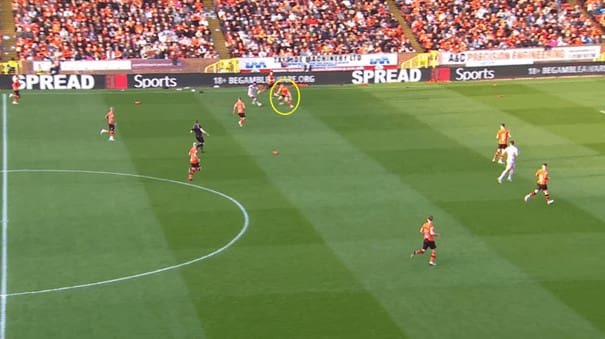
Here, McClelland gets out quickly to the advancing forward.
He ensures to jockey his opponent, not diving in, so his opponent doesn’t have a chance to go by him.
This allows his teammates to track back and help win possession back.
His quality is displayed by McClelland winning 75.6% of his defensive duels — the ninth-highest in the league.
Despite this quality and his height/physical stature, McClelland does show some inconsistency when defending aerially — he only won 51.6% of his aerial duels.
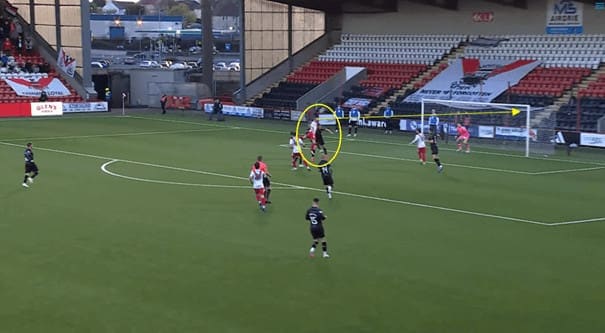
In this scenario, the ball has been crossed into the box.
McClelland has done an excellent job of getting close to the opposition’s centre-forward.
However, as the ball is crossed, he fails to get off the ground and is beaten easily in the air, allowing the centre-forward to get a shot off on goal.
McClelland had a percentile rank of only 27.6 for aerial duels win percentage per 90 when he was compared with other centre-backs in the Scottish Championship.
McClelland will hope to cement himself in the Scottish Premiership this season with St. Johnstone.
He will face competition from a host of centre-backs, including Lewis Neilson and new signing Kyle Cameron, and he will need to perform consistently to remain in the team.
Through his short spell at Dundee, McClelland has proven he is above the Scottish Championship level.
A move to EFL League 1 or 2 may be on the cards if McClelland fails to break into St. Johnstone’s side.
Conclusion
This Scottish Premiership analysis shows the quality of talent that is at the disposal of Scotland’s top sides.
Yet as our Scottish Championship scout report has shown, the 2nd tier has also proven a quality breeding ground for Scottish talent to develop.
Each player proved through their stints in Scotland’s second tier that they have the potential to play at a higher level and have become a more accomplished player as a result of their time on loan.
It will be interesting to see how the 2024/25 Scottish Premiership season develops.

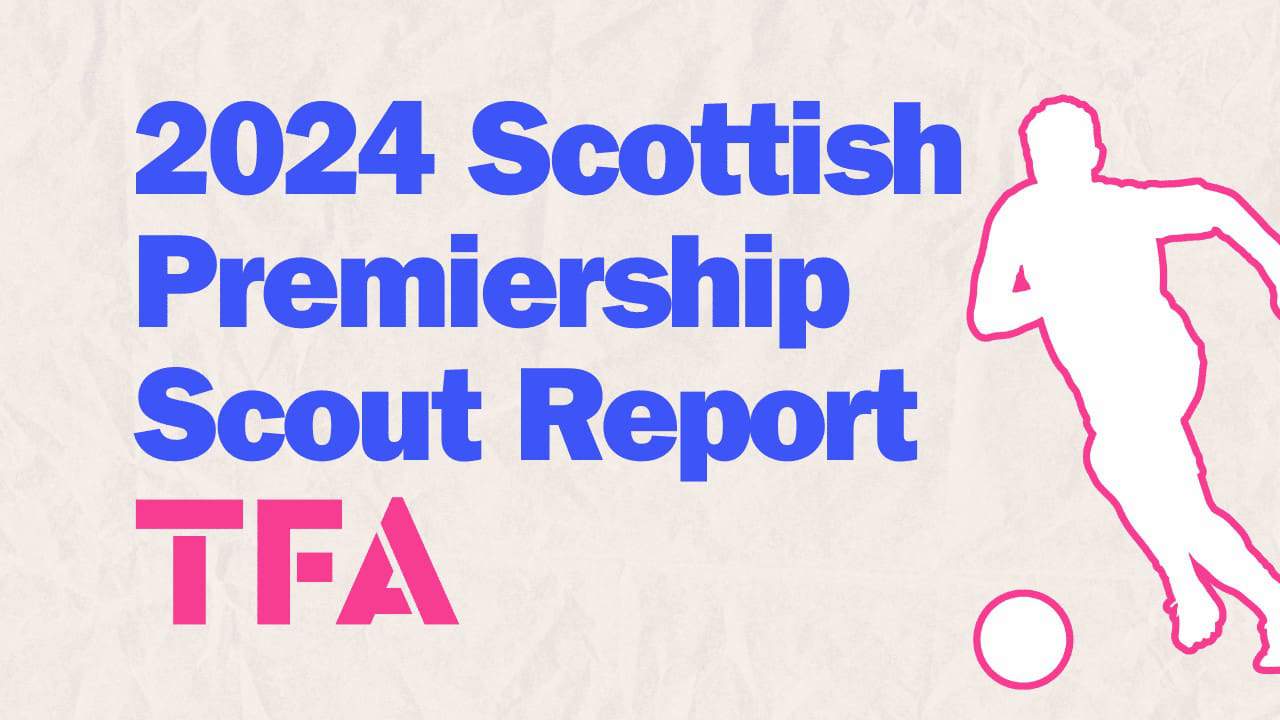



Comments